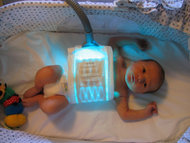Definition
Neonatal jaundice (or hyperbilirubinemia) is a higher-than-normal level of bilirubin in the blood. Bilirubin is a by-product of the breakdown of red blood cells. This condition can cause a yellow discoloration of the skin and the whites of the eyes called jaundice.
Description
Bilirubin, a by-product of the breakdown of hemoglobin (the oxygen-carrying substance in red blood cells), is produced when the body breaks down old red blood cells. Normally, the liver processes the bilirubin and excretes it in the stool. Hyperbilirubinemia means there is a high level of bilirubin in the blood. This condition is particularly common in newborn infants. Before birth, an infant gets rid of bilirubin through the mother's blood and liver systems. After birth, the baby's liver has to take over processing bilirubin on its own. Almost all newborns have higher than normal levels of bilirubin. In most cases, the baby's systems continue to develop and can soon process bilirubin. However, some infants may need medical treatment to prevent serious complications which can occur due to the accumulation of bilirubin.
Causes & symptoms
In newborn infants, the liver and intestinal systems are immature and cannot excrete bilirubin as fast as the body produces it. This type of hyperbilirubinemia can cause jaundice to develop within a few days after birth. About one-half of all newborns develop jaundice, while premature infants are much more likely to develop it. Hyperbilirubinemia is also more common in some populations, such as Native American and Asian. All infants with jaundice should be evaluated by a health care provider to rule out more serious problems.
Hyperbilirubinemia and jaundice can also be the result of other diseases or conditions. Hepatitis, cirrhosis of the liver, and mononucleosis are diseases that can affect the liver. Gallstones, a blocked bile duct, or the use of drugs or alcohol can also cause jaundice.
Extremely high levels of bilirubin in infants may cause kernicterus, a form of brain damage. Signs of severe hyperbilirubinemia include listlessness, high-pitched crying, apnea (periods of not breathing), arching of the back, and seizures. If severe hyperbilirubinemia is not treated, it can cause mental retardation, hearing loss, behavior disorders, cerebral palsy, or death.
Diagnosis
The initial diagnosis of hyperbilirubinemia is based on the appearance of jaundice at physical examination. The child is often placed by an open window so he/she may be checked in natural light. Blood samples may be taken to determine the bilirubin level in the blood.
Treatment
Most cases of newborn jaundice resolve without medical treatment within two to three weeks, but should be checked by the health care provider. It is important that the infant is feeding regularly and having normal bowel movements. If bilirubin levels are extremely high, the infant may be treated with phototherapy -- exposure of the baby's skin to fluorescent light. The bilirubin in the baby's skin absorbs the light and is changed to a substance that can be excreted in the urine. This treatment can be done in the hospital and is often done at home with special lights which parents can rent for the treatment. Treatment may be needed for several days before bilirubin levels in the blood return to normal. The baby's eyes are shielded to prevent the optic nerves from absorbing too much light. Another type of treatment uses a special fiberoptic blanket. There is no need to shield the baby's eyes with this treatment, and it can be done at home. In rare cases, where bilirubin levels are extremely high, the baby may need to receive a blood transfusion.
Prognosis
Most infants with hyperbilirubinemia and associated jaundice recover without medical treatment. Phototherapy is very effective in reducing bilirubin levels in the majority of infants who need it. There are usually no long-term effects on the child from the hyperbilirubinemia or the phototherapy. It is very rare that a baby may need a blood transfusion for treatment of this condition.
Prevention
There is no way to predict which infants will be affected by hyperbilirubinemia. Newborns should be breastfed or given formula frequently, and feedings should begin as soon as possible after delivery to increase activity of the baby's digestive system.
Key Terms
- Bilirubin
- A yellowish-brown substance in the blood that forms as old red blood cells are broken down.
- Hemoglobin
- A protein, an oxygen-carrying pigment of the erythrocyte (red blood cell) formed in the bone marrow.
- Jaundice
- A yellow discoloration of the skin and whites of the eyes.
- Kernicterus
- A serious condition where high bilirubin levels cause brain damage in infants.
Further Reading
For Your Information
Books
- "Hyperbilirubinemia." In The Merck Manual of Diagnosis and Therapy, edited by Robert Berkow. Rahway, NJ: Merck Research Laboratories, 1992.
Other
- D'Alessandro, Hellen Anne. Biliary Atresia. The Virtual Hospital, University of Iowa at http://www.vh.org/Providers/Textbooks/ElectricGiNucs/Text/BiliaryAtresia.html.
- Jaundice in Newborn (Hyperbilirubinemia). http://www.healthwise.com/ivillage/kbase/kbindex.asap.
- Jaundice/Hyperbilirubinemia. http://www2.medsch.wisc.edu/childrenshosp/Parents_of_Preemies/jaundice.html.
- Kernicterus in Cedars-Sinai Medical Center Newborn Intensive Care Unit Teaching Files. http://external.csmc.edu/neonatology/syllabus/kernicterus.html.
- Neonatal Jaundice. http://www.gi.vghtc.gov.tw/Teaching/Biliary/Jaundice/s13.htm.
Gale Encyclopedia of Medicine. Gale Research, 1999.



